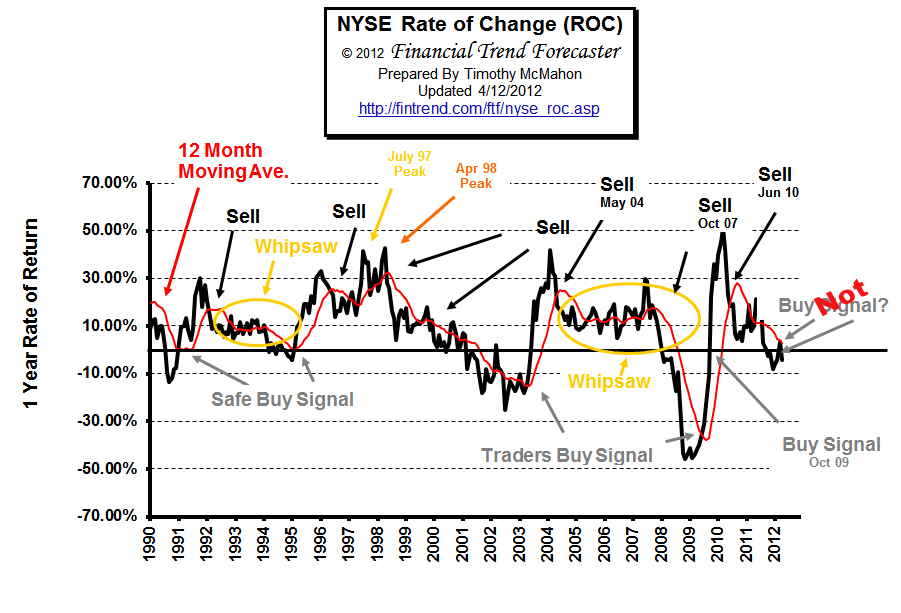Investing Using Moving Averages
When investing in financial markets, there are many different indicators and systems that you can use to determine when to enter into a position, and just as importantly, when to exit a position. One of the most popular indicators that investors employ to help make intelligent decisions are moving averages. What exactly is a moving average and how can you use it to invest in the financial markets?
What is a Moving Average?
Simply stated, a moving average is the average price of a stock over time.
To be a little more technical, a moving average is a statistical measurement (the mean) of a dynamic set of data (aka “rolling”) that helps to identify trends in the underlying instruments. A 13-week moving average provides the average price of the financial instrument using the stock prices for the preceding 13 weeks. A 50-week moving average uses data from the preceding 50 weeks, etc. Each new day, the oldest day’s data is removed from the population and the current day’s data is added; in this way the population is always equal to 13 weeks’ worth of data, measured from that day back.
The moving average is a linear measurement of the average price of a stock over the period in question. The line communicates the historic trend of a stock’s price. Most consumer trading platforms offer moving average indicator tools for use in technical analysis.
There are two different types of moving averages that you could use: simple and exponential.
Simple vs. Exponential Moving Averages
Although both the simple and exponential moving averages provide you with the same type of information, the way that these averages are calculated differ. With a simple moving average, the average is calculated by taking the average price of the security and dividing it by the number of periods that you are using. For example, if you are computing a five-day simple moving average, you take the closing price of the security for the last five days, add them and divide by five.
The exponential moving average uses a calculation that puts more emphasis on the most recent price data. Recent changes in price are given greater weight than the more historic measurements, which reflects a greater weight on current news and data than applying equal weight to all periods. This calculation effectively expresses the view that data today is more important (or pertinent) than older data.
Moving averages are a lagging indicator
As with all lagging indicators, moving averages communicate the direction that an instruments price has moved historically. While the past may predict the future, it may not. A moving average could very well be trending upward and a stock’s price can move downward. A moving average will also “smooth out” volatile data. So if prices bounce around a lot the moving average will provide a much clearer picture of the actual trend. For instance on Financial Trend Forecaster’s NYSE ROC chart you can see whether the 12 month Moving average (red line) is slanting down or up or is basically flat.

Trading Strategy: How to Use Moving Averages
Moving averages are best used in conjunction with other indicators and are often most valuable when a stock is trending in one direction or another (as opposed to trading in a range). Following are some common uses of moving averages in this situation:
- A moving that average is trending upward, and the current stock price is above the moving average, may communicate a bullish signal.
- A bullish (buy) indicator may also arise if a stock crosses the moving average (i.e. moves from below to above it); in contrast, if a stock drops below a moving average (from above), this indicates a bearish (Sell) sentiment.
Often, moving averages from different periods are used in conjunction with one another. A short-term moving average may be used in concert with a long-term moving average. If the short-term average moves above the long-term average, this may send a bullish signal (and vice versa).
The periods used should mirror your trading horizon. If you are a long-term investor, you should use longer-term moving averages. You can still use a “short” and a “long” term moving average, the averages should just mirror your trading philosophy. In other words, if you plan to hold a position for years, use averages that span weeks or months. If you plan to hold a position for days, then use averages that span hours or days. Using the wrong moving average for your overarching trading strategy will create confusing signals.
Using Moving Averages With Other Indicators
Many of the other indicators that you may use on your trading platform are based on moving average concepts. For example, the MACD (moving average convergence divergence) is an indicator that uses a fast moving average and a slow moving average to identify when trends are forming. Bollinger bands and some of the other leading indicators also use some kind of moving average.
When you plan on trading the market, moving averages can be a valuable tool to use, but they are generally best used in conjunction with other indicators.
For more information see: Moving Averages: Determining the Trend and Avoiding the Whipsaws
Also : Elliott Wave International (EWI) has released a free 10-page trading eBook: How You Can Find High-Probability Trading Opportunities Using Moving Averages, by Senior Analyst Jeffrey Kennedy. Download Your Free eBook Here.
About the Author:
April Santos manages her own financial portfolio and actively uses moving averages as a basis for her technical research, particularly when making entry and exit decisions. She also works as a freelance writer for the team at www.generalinsuranceagency.com, who believe that everyone should work to develop their financial acumen.
[…] What is a Moving Average? […]